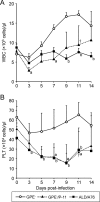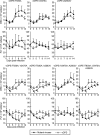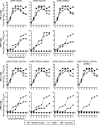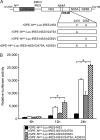Selection of classical swine fever virus with enhanced pathogenicity reveals synergistic virulence determinants in E2 and NS4B
- PMID: 22674973
- PMCID: PMC3421723
- DOI: 10.1128/JVI.00551-12
Selection of classical swine fever virus with enhanced pathogenicity reveals synergistic virulence determinants in E2 and NS4B
Abstract
Classical swine fever virus (CSFV) is the causative agent of classical swine fever (CSF), a highly contagious disease of pigs. There are numerous CSFV strains that differ in virulence, resulting in clinical disease with different degrees of severity. Low-virulent and moderately virulent isolates cause a mild and often chronic disease, while highly virulent isolates cause an acute and mostly lethal hemorrhagic fever. The live attenuated vaccine strain GPE(-) was produced by multiple passages of the virulent ALD strain in cells of swine, bovine, and guinea pig origin. With the aim of identifying the determinants responsible for the attenuation, the GPE(-) vaccine virus was readapted to pigs by serial passages of infected tonsil homogenates until prolonged viremia and typical signs of CSF were observed. The GPE(-)/P-11 virus isolated from the tonsils after the 11th passage in vivo had acquired 3 amino acid substitutions in E2 (T830A) and NS4B (V2475A and A2563V) compared with the virus before passages. Experimental infection of pigs with the mutants reconstructed by reverse genetics confirmed that these amino acid substitutions were responsible for the acquisition of pathogenicity. Studies in vitro indicated that the substitution in E2 influenced virus spreading and that the changes in NS4B enhanced the viral RNA replication. In conclusion, the present study identified residues in E2 and NS4B of CSFV that can act synergistically to influence virus replication efficiency in vitro and pathogenicity in pigs.
Figures







Similar articles
-
Npro of classical swine fever virus contributes to pathogenicity in pigs by preventing type I interferon induction at local replication sites.Vet Res. 2014 Apr 17;45(1):47. doi: 10.1186/1297-9716-45-47. Vet Res. 2014. PMID: 24742209 Free PMC article.
-
The Unique Glycosylation at Position 986 on the E2 Glycoprotein of Classical Swine Fever Virus Is Responsible for Viral Attenuation and Protection against Lethal Challenge.J Virol. 2022 Jan 26;96(2):e0176821. doi: 10.1128/JVI.01768-21. Epub 2021 Nov 3. J Virol. 2022. PMID: 34730400 Free PMC article.
-
Intracellular membrane association of the N-terminal domain of classical swine fever virus NS4B determines viral genome replication and virulence.J Gen Virol. 2015 Sep;96(9):2623-2635. doi: 10.1099/vir.0.000200. Epub 2015 May 26. J Gen Virol. 2015. PMID: 26018962
-
Approaches to define the viral genetic basis of classical swine fever virus virulence.Virology. 2013 Apr 10;438(2):51-5. doi: 10.1016/j.virol.2013.01.013. Epub 2013 Feb 13. Virology. 2013. PMID: 23415391 Review.
-
Genetic variability and distribution of Classical swine fever virus.Anim Health Res Rev. 2015 Jun;16(1):33-9. doi: 10.1017/S1466252315000109. Anim Health Res Rev. 2015. PMID: 26050570 Review.
Cited by
-
Impact of a Live Attenuated Classical Swine Fever Virus Introduced to Jeju Island, a CSF-Free Area.Pathogens. 2019 Nov 20;8(4):251. doi: 10.3390/pathogens8040251. Pathogens. 2019. PMID: 31756940 Free PMC article.
-
Classical swine fever: Unveiling the complexity through a multifaceted approach.Open Vet J. 2024 Oct;14(10):2497-2508. doi: 10.5455/OVJ.2024.v14.i10.1. Epub 2024 Oct 31. Open Vet J. 2024. PMID: 39545196 Free PMC article. Review.
-
Virus Adaptation and Selection Following Challenge of Animals Vaccinated against Classical Swine Fever Virus.Viruses. 2019 Oct 10;11(10):932. doi: 10.3390/v11100932. Viruses. 2019. PMID: 31658773 Free PMC article.
-
Npro of classical swine fever virus contributes to pathogenicity in pigs by preventing type I interferon induction at local replication sites.Vet Res. 2014 Apr 17;45(1):47. doi: 10.1186/1297-9716-45-47. Vet Res. 2014. PMID: 24742209 Free PMC article.
-
Analysis of Virus Population Profiles within Pigs Infected with Virulent Classical Swine Fever Viruses: Evidence for Bottlenecks in Transmission but Absence of Tissue-Specific Virus Variants.J Virol. 2020 Sep 15;94(19):e01119-20. doi: 10.1128/JVI.01119-20. Print 2020 Sep 15. J Virol. 2020. PMID: 32699086 Free PMC article.
References
MeSH terms
Substances
LinkOut - more resources
Full Text Sources

